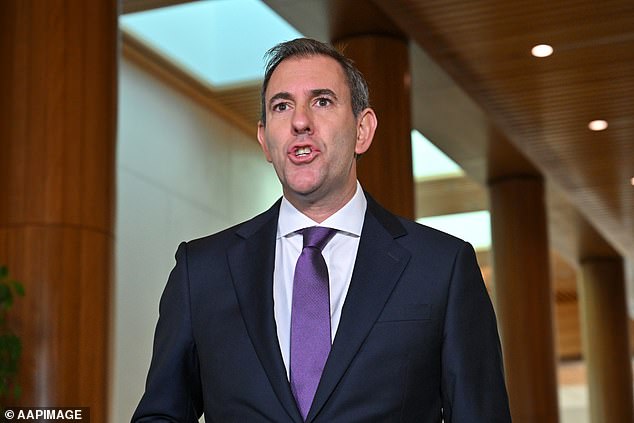- Jim Chalmers calls emergency crisis talks on Trump
Treasurer Jim Chalmers has called an emergency crisis meeting of Australia’s top economic officials to deal with Donald Trump‘s tariffs as the Australian dollar plummets.
The unprecedented gathering during an election campaign has occurred after the Trump Administration threatened to impose 104 per cent tariffs on China, Australia’s biggest trading partner.
Financial markets are now expecting another 100 basis points of Reserve Bank interest rate cuts by the end of 2025, causing the Australian dollar to sink to a new, five-year low of 59 US cents on Wednesday morning.
‘We’re working closely with the regulators and financial institutions to ensure that everything possible is being done to safeguard Australians from this global volatility,’ Mr Chalmers said.
Reserve Bank of Australia Governor Michele Bullock and Treasury Secretary Steven Kennedy are being summonsed.
Banking regulator John Lonsdale, the chairman of the Australian Prudential Regulation Authority, will also be in attendance along with Australian Securities and Investments Commission chair Joe Longo and Australian Competition and Consumer Commission chief Gina Cass-Gottlieb.
Fears about a global recession have hit the Australian dollar, which on Wednesday fell to 59 US cents for the first time since March 2020 during the start of Covid.
The futures market now regards a super-sized 50 basis point Reserve Bank interest rate cut on May 20 as an 82 per cent chance.

Treasurer Jim Chalmers has called an emergency crisis meeting of Australia’s top economic officials to deal with Donald Trump ‘s tariffs
It also sees the RBA cutting rates to 3.1 per cent by the end of 2025, down from 4.1 per cent now.
Another 100 basis points worth of cuts, on top of February’s easing, would see the cash rate fall to the lowest level since February 2023.
AMP deputy chief economist Diana Mousina said the Reserve Bank cash rate was now likely to fall to 3.1 per cent by 2026, which would be lower than the average level of the 2010s when inflation was consistently below the RBA’s 2 to 3 per cent target.
‘Interest rates are likely to fall further this year and the growth threat from tariffs increases the need for rate cuts,’ she said.
‘We expect the cash rate to decline to 3.6 per cent by the end of this year and to end the cutting cycle at 3.1 per cent.
‘This is higher than average interest rates in the decade prior to Covid.’
Ms Mousina said the sharp share market plunges this week, which saw $119billion wiped from the benchmark S&P/ASX200 on Monday, made a large rate cut in May more likely.
‘The large falls in global share markets from US tariffs and the potential hit to global growth means that larger and faster rate cuts could occur in coming months and a 50 basis point rate cut can’t be ruled out at the May meeting,’ she said.
The Trump Administration is inflicting 10 per cent tariffs on Australia despite the US having a trade surplus with Australia dating back to 1952.
Prohibitive tariffs on China are expected to see Asian nations flood Australian with cheap goods, which could potentially bring down inflation.
This would occur even with a weak Australian dollar, which would traditionally make imports more expensive.

The unprecedented gathering during an election campaign has occurred after the Trump Administration threaten to impose 104 per cent tariffs on China , Australia’s biggest trading partner (pictured is US President Donald Trump with coal miners in the White House)

Leave a Reply